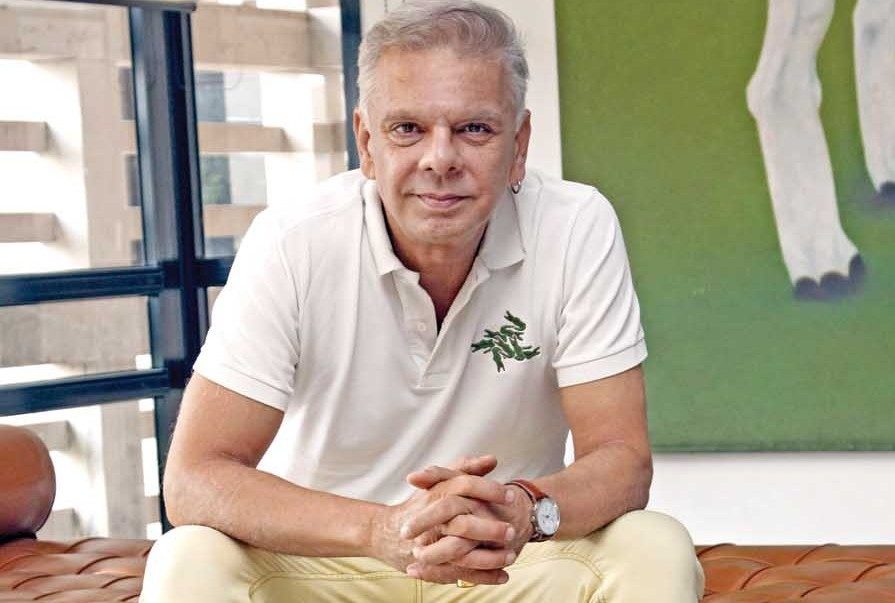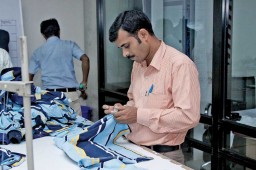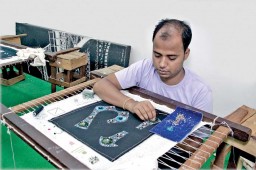
While India has always been a preferred supplier in the small quantity value-added segment, it is only in the last few years that recognition of its craft at a higher level is visible. Traditionally, the high-end market has been fed by two working methods – one, wherein the embroidered panel is made in India, stitched on to a dummy dress and sent to be added to a designer dress manufactured in a western country or where the foreign designer gives all the technical details and uses the relatively ‘cheaper’ and ‘flexible’ manufacturing unit of Indian partners to produce the goods. What is common to both is that the final touch is given in the fashion capitals of the world, with no credit to the Indian expertise.
Exporters working in this category are very clear on the strategy. “Why would the Italians let go of the ‘Made in Italy’ advantage,” argues Ashish Chadha, Director, Apt Design, which in the last four years since its inception has bagged some of the best work from top fashion houses in Italy. Ravi Gupta of Moonstitch, who is also successfully feeding the couture market, feels that India has the technique and skills to manufacture for the luxury market though the segment is still only looking at value additions. “As of now, even the products which many claim are being made in India, are basically embroidered in the country, given a temporary stitching and then sent to be finally stitched in Italy or France for a ‘Made in Italy/France label, which adds value to the price ticket.”
Companies that are stitching the garments for the designers admit they are pure converts. “We are just manufacturers; the concept, cut, design and applications are the brainchild of the buyers,” says Vikram Sahani, MD, Ski. He adds, “There are too many cultural differences for us to even understand their taste and there is no pretensions, we are responsible only for quality production and committed to deliver on time.” Through this model a number of designer brands/houses including Giorgio Armani, Dolce Gabana, Louis Vuitton, Roberto Cavalli, Hugo Boss, Calvin Klien, Galeries Lafayette, Roberta Freymann, British India, and many celebrity brands like Jlo, Sophie Auster, Donna Karan and Antonio Banderas to name a few are being manufactured in the country. With the global market for luxury goods valued at US $ 296.15 billion in 2013 and expected to reach US $ 374.85 billion in 2020, the scope for bigger business in luxury items is immense as clothing accounts for around 40% of the luxury market.
With international exposure coming in, many mature companies are leading the emergence of a new business model wherein companies like DTM Resources, Mumbai are working with leading design houses across the world and open to collaborations with emerging designers, to provide a design to finished product option. “Luxury designer level product requires a great attention to detail and strong sense of urgency. It also requires an inherent understanding of the market and design sensibility. A manufacturer must be a designer, product developer, trend forecaster and also a very good maker. All of these things are necessary, without one it will be difficult to work with a demanding luxury client,” shares Tarun Sharma, Director, DTM Resources. DTM is led by a team of directors that have been trained in New York and Italy, so they not only have keen knowledge of the fashion industry, but also understand the sensibility of the west. “We strive to provide our clients with a superior level of customer service and offer solutions for all of their design, sourcing and manufacturing needs. For this reason, our people are intimately involved in every step of the manufacturing process and all of our embroidery, stitching and finishing are done under the watchful supervision of our directors,” informs Tarun.
Taking the model a step further, the fourth and most rare of the lot are those companies which not only manufacture for the best of brands but also have successful ready-to-wear lines for the international market like Ogaan and Lecoanet Hemant India. These companies are successfully combining the two words ‘industrial’ and ‘luxury’ to feed the international market with design and quality. In fact, even after a successful venture in Paris with business partner Didier Lecoanet, Hemant Sagar, opted to return to India as Director, Lecoanet Hemant India to fill the void created by the declining number of haute couture manufacturers and the ever-increasing demand for haute couture. “I had to come back to India to set-up an industrial fashion house of certain scale,” states Hemant.
The chances are that a beautifully embroidered designer outfit, whether bought in New York or Paris, would have used the skills of Indian craftsmen for the intricate value addition. Today, many Indian entrepreneurs are harnessing the talent of thousands of handworkers to give delicately embroidered panels to some of the most reputed design houses in Europe and America… but some have gone a step further and sharpened manufacturing competence to give not just the value addition, but the whole garment, bearing the label of the design house proudly. Is India maturing as a ‘designer manufacturing’ hub… an interesting thought!
Inspiration to set-up an industrial manufacturing unit in India has come from luxury brands like Ferragamo, LV, Fendi, Hermès and BottegaVeneta, whose products are hand-made but in an industrial environment. Presently, Lecoanet Hemant India has a setup of 700 sewing machines, 4 embroidery machines and a hand embroidery setup of 40 people in-house and 400 outsourced, in Gurgaon (Delhi-NCR). For high fashion products, the Make Through production system is used to ensure maximum control over the quality of the product and consistent output. Today, 80% of revenue for Lecoanet Hemant India comes from the exports of haute and prêt couture products to luxury brands in Europe and USA. “It is not just the amenities provided by us, rather the environment of the company where the focus is on making sewing operators the dress makers,” shares Hemant.
Another fashion designer who has made a mark globally as an exporter of RTW is Kavita Bhartia. Using many Indian techniques including block printing, which is done in-house, Ogaan is supplying to a wide range of clients a creative collection of garments from US $ 15 Kaftans and beachwear to US $ 300 and above dresses. “Being a design house we understand the pulse of fashion and interpret prints and embroidery in contemporary ways to appeal international audience. Matching the market segment need, we create products which are high-end and with assured quality right from pieces that are of just US $ 15; how can we treat two garments coming from us differently on quality parameters. What does differ is the fabric, number of techniques used, degree of difficulty in executing the design and of course the brand name attached,” says Geeta Govil Sen, Export Manager, Ogaan.
Whatever be the business model, the focus of all the companies is to produce ‘right-the-first-time’ or ‘zero defects’ quality levels as rejections and alterations add to the downstream cost of the product, which is exponentially higher in high fashion productions. “When the FOBs are US $ 100 and above, where is the scope for error. We can’t even afford to make extra pieces,” reasons Ravi, who is doing extensive work for Versace, Dior, LV, Gucci and the likes, besides working for celebrity labels like Victoria Beckham.
Increasingly, where production is happening, it is becoming as important as the quality of the product. “All of our work is done with social responsibility in mind and we adhere to strict policies regarding our skilled team and work environment. In addition, we support artisan communities whenever possible and offer many opportunities to our clients to work with local craft in a variety of mediums,” shares Tarun. At Lecoanet Hemant India, many training programs and workshops are conducted for its employees, spreading awareness about workplace sexual harassment, family planning and alcohol addiction. Yet addressing the concerns of ‘compliance’ is a struggle. “It is a tricky situation, since the work involves handwork which sometimes cannot be done in-house and has to be outsourced from villages that specialize in that particular technique. In such cases, it is difficult to control the people and environment in which the work is done,” reasons Ashish. However, all agree that most of the buyers recognize the limitations and there is an unsaid but clear understanding of what is permissible and what is a definite ‘no-no’.
That is perhaps why many of the exporters are trying to get the handwork done in-house or at clusters approved by third-party auditors. “It is becoming important to have as many technique facilities as possible within the factory as buyers are giving preference to such manufacturers,” says Vikram. In fact the two most critical strengths that make an exporter in this category a preferred supplier is flexibility of operations and facilities for different technique applications.
With Indian manufacturers upping there facilities and willing to work on design and quality stitching, global luxury brands are increasingly taking advantage of India’s human resources available at a more reasonable price. Brands like ‘Louis Vuitton’ and Italian Textile Company ‘Frette’ known for its premium linen are looking at India as a manufacturing base for their products. Last year, the former India Chief of Louis Vuitton, Regis Fournier, made news by announcing his intention to invest Rs. 350 crore in a facility in Puducherry to manufacture and supply to the world’s top luxury labels. Now it is for companies, willing to work in this very interesting market segment, to balance quantities, quality and price points with skill and manufacturing excellence.








